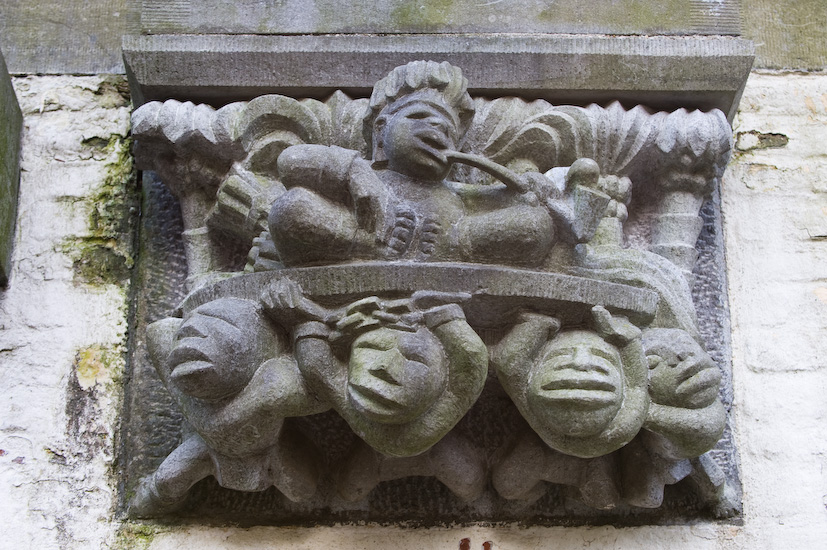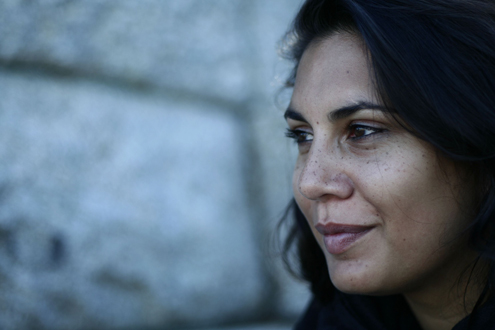 Hiding in plain view - Dealing with the legacies of Dutch slavery. Street-light console ‘De Moriaan’ at the Oudegracht in the Utrecht inner city.
Hiding in plain view - Dealing with the legacies of Dutch slavery. Street-light console ‘De Moriaan’ at the Oudegracht in the Utrecht inner city. Artikel: Hiding in plain view: Dealing with the legacies of Dutch slavery
The year 2013 marks 150 years since the abolition of slavery in the former Dutch colonies. It’s worth mentioning that the Dutch abolished slavery a while after the British (1833) and French (1848) and, only after much resistance.
Melissa Weiner, an American sociologist, has done some outstanding and research on the representation of the Dutch history of slavery. She has studied depictions of slavery and multiculturalism in Dutch primary school history textbooks and norms and practices privileging whiteness in a diverse Dutch primary school classroom. Weiner’s findings, which will be published soon, are quite telling of the Dutch attitude towards the legacy of slavery. This attitude is a mix of denial, ignorance, (supposed) innocence, and misplaced entitlement. Resistance to the dominant Dutch historic narrative is often met with aggression, marginalization and disdain. People that do question the dominant narrative — from activists to scholars — are often subjected to some fine Dutch repression, not only in everyday life but also institutionally. Try get funding as a scholar to research racism in the Netherlands or set up black, postcolonial, ‘critical race’ or any critical studies departments in this country – it will never happen.
One of the efforts to mark the occasion is The Next Step, a master class for upcoming films talents and a program for high school kids by Africa in the Picture, an African Film Festival based in the Netherlands. The central question of the The Next Step program is: ‘What does slavery mean to you, anything or nothing?’
Young filmmakers and high school students are challenged to make a 150 second film related to this question.While the legacy of slavery should mean something to everyone in the Netherlands, due to the lack of education on slavery, the politics around the commemoration of the abolishment of slavery and the silence of families that became wealthy through the slave trade means that many believe that slavery was really just a ‘black page in history.’ This phrase is frequently used by the Dutch to discuss the legacy of slavery. This is not only a false representation of history but also insulting given that the legacies of slavery are so present today – hiding in plain view.
An additional educational program on slavery is much needed and one hopes many young filmmakers and high schools will start thinking about the legacies of slavery and the role of the Dutch in this history. I say this especially because I have very little faith in the actual Dutch educational system to teach children about slavery. Being schooled in the Netherlands myself, I did not learn about slavery in school until my parents told me about it.
Part of the Africa in the Picture program was the documentary film, Traces of the Trade by Katrina Browne, who discovered that her New England ancestors, the DeWolf family, were the largest slave-trading family in U.S. history:
The story of the DeWolf family is one that probably resembles many stories of Dutch slave trader families in the Netherlands. The legacies of slavery are everywhere around us: from the canal houses, graves of unnamed slaves, the depiction of black people in Dutch paintings and ornaments on the streets of Amsterdam, all the spices that are available to us, to the undeniable presence of people from the former colonies that live here.
Weiner studied 203 textbooks and found that only 96 mention any kind of slavery (47,3%). Only 49 mention black slavery in the Dutch colonies (24,1%). The books barely talk about resistance to slavery; only 10 books (20.1%) speak about resistance of slavery on the plantations. Tula, who was enslaved on Curaçao and was leader of the 1795 slave revolt, is not mentioned once. A Dutch Caribbean film about Tula, ‘Tula: the Revolt’ (the first feature film to portray Dutch colonial history; trailer below) just came out and already stirred up conversations about ownership of legacies and representation back in 2011.
Weiner has also looked into how books speak about slavery. The focus is on what the Dutch colonists, not those they enslaved, had to endure. Any 10-year old student confronted with this past, may very well get the impression that slavery was quite an ordeal for the Dutch with phrases such as ‘the Dutch had a very hard time on the plantations’ or the Middle Passage was ‘a dangerous undertaking [for the Dutch]’. Another writes: ‘The Dutch found slavery very normal for over 200 years.’ It seems they still do. Contemporary legacies of slavery and the commemoration are hardly addressed either. Only 6 books mention Keti Koti, the commemoration of the abolishment of slavery in the Netherlands and Suriname on July 1, 1863.
On a side note, the depictions of Africa and multiculturalism in primary school textbooks do not score high either. Let’s just say that the AIAC tagline is pretty accurate here: Dutch textbooks basically say and show that Africa is one big country, filled with famine and violence from which only UNICEF or Bono can rescue Africans because ‘independence is not always a good thing.’
So yes, extra educational programs are much needed to make sure that kids do engage with the history of slavery and stop thinking that Dutch history is only about World War II (in this instance, the story is one of resistance, rather than the massive compliance and complicity with the Nazis). We should be worried about the fact that the legacies of slavery are so present but are denied, not spoken about and deemed as unimportant because its ‘that long ago’.
What happens after this year that marks 150 years of commemoration (actually it should be 140 years since the end of slavery because it took the Dutch another 10 years to abolish slavery completely) that is filled with special slavery exhibitions, plays and books and projects? And yes, it does matter because the legacies of slavery and racism are real and tangible today, as is the fact that there was a system in place through which people benefited from slavery, which has subsequently influenced their privileged positions in society today.
Weiner found one primary school textbook that mentions racism in the Netherlands today. That comes as no surprise but it does mean that we’ll be needing a lot of 150 second films to tackle the idea that racism has seized to exist and that slavery is just ‘a black page in history’.
By Chandra Frank
Chandra Frank is part of Redmond, an intersectional feminist media collective based in Amsterdam that produces radio, blogs and organizes events. She received an MPhil from the University of Cape Town in African Studies in 2012. For Framer Framed she curated the exhibition Re(as)sitting Narratives (2016). The exhibition is focused on lingering colonial legacies between South Africa and the Netherlands through engaging with contemporary artists from both countries.
This article was originally posted on Africa is a Country.
- Africa is a Country
Links
Slavernij / Suriname /
Netwerk
